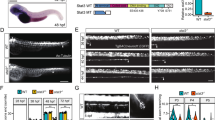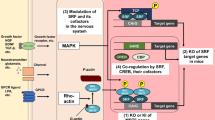Abstract
A basal tone of the endocannabinoid 2-arachidonoylglycerol (2-AG) enhances late oligodendrocyte progenitor cell (OPC) differentiation. Here, we investigated whether endogenous 2-AG may also promote OPC proliferation in earlier stages. We found that the blockade of 2-AG synthesizing enzymes, sn-1-diacylglycerol lipases α and β (DAGLs), with RHC-80267 or the antagonism of either CB1 or CB2 cannabinoid receptors with AM281 and AM630, respectively, impaired early OPC proliferation stimulated by platelet-derived growth factor (PDGF-AA) and basic fibroblast growth factor (bFGF). On the contrary, increasing the levels of endogenous 2-AG by blocking the degradative enzyme monoacylglycerol lipase (MAGL) with JZL-184, significantly increased OPC proliferation as did agonists of cannabinoid receptor CB1 (ACEA), CB2 (JWH133) or both (HU-210). To elucidate signaling pathways underlying OPC proliferation, we studied the involvement of phosphatidylinositol 3-kinase (PI3K)/Akt and its downstream target mammalian target of rapamycin (mTOR). We show that phosphorylation of Akt and mTOR is required for OPC proliferation stimulated by growth factors (PDGF-AA and bFGF) or by CB1/CB2 agonists (ACEA/JWH133), since it was strongly decreased after LY294002 or rapamycin treatment. In line with this, blockade of CB1 (AM281), CB2 (AM630) or DAGLs (RHC-80267), decreased phosphorylation of Akt, mTOR and 4E-BP1, diminished cyclin E-cdk2 complex association and increased p27kip1 levels. Our data suggest that proliferation of early OPCs stimulated by PDGF-AA and bFGF depends on the tonic activation of cannabinoid receptors by endogenous 2-AG and provide further evidence on the role of endocannabinoids in oligodendrocyte development, being important for the maintenance and self-renewal of the OPCs. The results highlight the therapeutic potential of the endocannabinoid signaling in the emerging field of brain repair.




Similar content being viewed by others
References
Aguado T, Monory K, Palazuelos J, Stella N, Cravatt B, Lutz B et al (2005) The endocannabinoid system drives neural progenitor proliferation. FASEB J 19:1704–1706
Aguado T, Palazuelos J, Monory K, Stella N, Cravatt B, Lutz B, Marsicano G, Kokaia Z, Guzmán M, Galve-Roperh I (2006) The endocannabinoid system promotes astroglial differentiation by acting on neural progenitor cells. J Neurosci 26:1551–1561
Arevalo-Martín A, Garcia-Ovejero D, Rubio-Araiz A, Gomez O, Molina-Holgado F, Molina-Holgado E (2007) Cannabinoids modulate Olig2 and polysialylated neural cell adhesion molecule expression in the subventricular zone of post-natal rats through cannabinoid receptor 1 and cannabinoid receptor 2. Eur J Neurosci 26:1548–1559
Bernal-Chico A, Canedo M, Manterola A, Victoria Sánchez-Gómez M, Pérez-Samartín A, Rodríguez-Puertas R, Matute C, Mato S (2015) Blockade of monoacylglycerol lipase inhibits oligodendrocyte excitotoxicity and prevents demyelination in vivo. Glia 63:163–176
Casaccia-Bonnefil P, Hardy RJ, Teng KK, Levine JM, Koff A, Chao MV (1999) Loss of p27Kip1 function results in increased proliferative capacity of oligodendrocyte progenitors but unaltered timing of differentiation. Development 126:4027–4037
Compagnucci C, Di Siena S, Bustamante MB, Di Giacomo D, Di Tommaso M, Maccarrone M et al (2013) Type-1 (CB1) cannabinoid receptor promotes neuronal differentiation and maturation of neural stem cells. PLoS One 8:e54271
Frederick TJ, Wood TL (2004) IGF-I and FGF-2 coordinately enhance cyclin D1 and cyclin E–cdk2 association and activity to promote G1 progression in oligodendrocyte progenitor cells. Mol Cell Neurosci 25:480–492
Galve-Roperh I, Chiurchiù V, Díaz-Alonso J, Bari M, Guzmán M, Maccarrone M (2013) Cannabinoid receptor signaling in progenitor/stem cell proliferation and differentiation. Prog Lipid Res 52:633–650
Ghiani CA, Eisen AM, Yuan X, DePinho RA, McBain CJ, Gallo V (1999) Neurotransmitter receptor activation triggers p27Kip1 and p21CIP1 accumulation and G1 cell cycle arrest in oligodendrocyte progenitors. Development 126:1077–1090
Ghiani C, Gallo V (2001) Inhibition of cyclin E-cyclin-dependent kinase 2 complex formation and activity is associated with cell cycle arrest and withdrawal in oligodendrocyte progenitor cells. J Neurosci 21:1274–1282
Gomez O, Arevalo-Martin A, Garcia-Ovejero D, Ortega-Gutierrez S, Cisneros JA, Almazan G, Sanchez-Rodriguez MA, Molina-Holgado F, Molina-Holgado E (2010) The constitutive production of the endocannabinoid 2-arachidonoylglycerol participates in oligodendrocyte differentiation. Glia 58:1913–1927
Gomez O, Sanchez-Rodriguez A, Le M, Sanchez-Caro C, Molina-Holgado F, Molina-Holgado E (2011) Cannabinoid receptor agonists modulate oligodendrocyte differentiation by activating PI3K/Akt and the mammalian target of rapamycin (mTOR) pathways. B J Pharmacol 163:1520–1532
Harkany T, Guzman M, Galve-Roperh I, Berghuis P, Devi LA, Mackie K (2007) The emerging functions of endocannabinoid signaling during CNS development. Trends Pharmacol Sci 28:83–92
Herkenham M, Lynn AB, Johnson MR, Melvin LS, de Costa BR, Rice KC (1991) Characterization and localization of cannabinoid receptors in rat brain: a quantitative in vitro autoradiographic study. J Neurosci 11:563–583
Katona I, Freund TF (2012) Multiple functions of endocannabinoid signaling in the brain. Annu Rev Neurosci 35:529–558
Long JZ, Li W, Booker L, Burston JJ, Kinsey SG, Schlosburg JE, Pavon FJ, Serrano AM, Selley DE, Parsons LH, Lichtman AH, Cravatt BF (2009) Selective blockade of 2-arachidonoylglycerol hydrolysis produces cannabinoid behavioral effects. Nat Chem Biol 5:37–44
Mato S, Alberdi E, Ledent C, Watanabe M, Matute C (2009) CB1 cannabinoid receptor-dependent and -independent inhibition of depolarization-induced calcium influx in oligodendrocytes. Glia 57:295–306
Molina-Holgado E, Vela JM, Arevalo-Martın A, Almazan G, Molina-Holgado F, Borrell J, Guaza C (2002) Cannabinoids promote oligodendrocyte progenitor survival: Involvement of cannabinoid receptors and phosphatidylinositol-3kinase/Akt signaling. J Neurosci 22:9742–9753
Molina-Holgado F, Rubio-Araiz A, García-Ovejero D, Williams RJ, Moore JD, Arévalo-Martín A et al (2007) CB2 cannabinoid receptors promote mouse neural stem cell proliferation. Eur J Neurosci 25:629–634
Palazuelos J, Aguado T, Egia A, Mechoulam R, Guzman M, Galve-Roperh I (2006) Non-psychoactive CB2 cannabinoid agonists stimulate neural progenitor proliferation. FASEB J 20:2405–2407
Palazuelos J, Ortega Z, Díaz-Alonso J, Guzmán M, Galve-Roperh I (2012) CB2 cannabinoid receptors promote neural progenitor cell proliferation via mTORC1 signaling. J Biol Chem 287:1198–11209
Pertwee RG (2005) Pharmacological actions of cannabinoids. Handb Exp Pharmacol 168:1–51
Sim FJ, Lang JK, Waldau B, Roy NS, Schwartz TE, Pilcher WH, Chandross KJ, Natesan S, Merrill JE, Goldman SA (2006) Complementary patterns of gene expression by human oligodendrocyte progenitors and their environment predict determinants of progenitor maintenance and differentiation. Ann Neurol 59:763–779
Trazzi S, Steger M, Mitrugno VM, Bartesaghi R, Ciani E (2010) CB1 cannabinoid receptors increase neuronal precursor proliferation through AKT/glycogen synthase kinase-3beta/beta-catenin signaling. J Biol Chem 285:10098–10109
Williams EJ, Walsh FS, Doherty P (2003) The FGF receptor uses the endocannabinoid signaling system to couple to an axonal growth response. J Cell Biol 160:481–486
Zuchero JB, Barres BA (2013) Intrinsic and extrinsic control of oligodendrocyte development. Curr Opin Neurobiol 23:914–920
Acknowledgments
This research was funded by the Ministry of Economy and Competitiveness of Spain to EM-H (MINECO, Instituto de Salud Carlos III; PI11/1729). SO-G was funded by MINECO (SAF2013-48271) and Comunidad de Madrid (S2010/BMD-2353). CG was supported by Red Española de Esclerosis Múltiple (REEM) RD12/0032/0008 sponsored by the Instituto de Salud Carlos III. We thank Drs A. Arevalo-Martin and D. Garcia-Ovejero and G. Almazan for valuable discussion and critical reading of the manuscript. We are grateful to Drs J.A. Rodríguez-Alfaro and J. Mazario (Servicio de Microscopia, Hospital Nacional de Paraplejicos) for their excellent technical assistance. The contribution of Ms. C. Sanchez-Caro in this work is sincerely acknowledged.
Conflict of Interest
The authors declare that they have no conflict of interest.
Author information
Authors and Affiliations
Corresponding authors
Rights and permissions
About this article
Cite this article
Gomez, O., Sanchez-Rodriguez, M.A., Ortega-Gutierrez, S. et al. A Basal Tone of 2-Arachidonoylglycerol Contributes to Early Oligodendrocyte Progenitor Proliferation by Activating Phosphatidylinositol 3-Kinase (PI3K)/AKT and the Mammalian Target of Rapamycin (MTOR) Pathways. J Neuroimmune Pharmacol 10, 309–317 (2015). https://doi.org/10.1007/s11481-015-9609-x
Received:
Accepted:
Published:
Issue Date:
DOI: https://doi.org/10.1007/s11481-015-9609-x




